Analysis of the China’s Interprovincial Innovation Connection Network Based on Modified Gravity Model
Abstract
:1. Introduction
2. Research Scope and Data Source
3. Methods
3.1. Entropy Weight Method
3.2. Modified Gravity Model
4. Analysis of the Pattern and Evolution of Interprovincial Innovation Connection in China
4.1. Construction of China’s Interprovincial Innovation Connection Index System
- From 2009 to 2019, in the criteria layer, the weight of innovation output was the highest, while the weight of innovation environment was the lowest. Additionally, the weight of the innovation environment continued to rise, while the weight of innovation output continued to decline.
- From 2009 to 2019, in the index layer, the weight of per capita GDP (CNY) was the lowest, and the weight of output value of new products of high-tech industry (CNY 10,000) was the highest. Among them, in terms of innovation environment, the total postal business (CNY 10,000) and the weight of the number of students in adult higher education (people) increased, while the total telecommunications services (CNY 10,000), the number of Internet users (10,000 households), and the weight of per capita GDP (CNY) decreased. In terms of innovation investment, the weight of research and experimental development (R&D) personnel (person/year), financial education expenditure (CNY 10,000), research and experimental development (R&D) expenditure (CNY 10,000), and new product development expenditure of industrial enterprises above designated size (CNY 10,000) increased year by year. In terms of innovation output, the weight of the number of patent applications (pieces), the number of patents granted (pieces), and the number of scientific and technological works published (article) decreased year by year.
4.2. Analysis of China’s Interprovincial Innovation Connection
4.2.1. Characteristics of China’s Interprovincial Innovation Connection Pattern
- The overall spatial structure of China’s interprovincial innovation network shows a “core periphery” feature, radiating from coastal provinces such as Jiangsu, Beijing, and Zhejiang to inland provinces, and exhibiting an overall pattern of “strong in the east and weak in the west” (Figure 2).
- From a regional perspective, the economically developed coastal areas of China, such as the Bohai Rim region and the Yangtze River Delta region, have extremely strong or strong innovation connections in local areas, but their innovation connections with other provinces outside the region are average, indicating that the innovation impact of regions with strong innovation is insufficient. In addition, the innovation connections between Guangdong Province and other provinces are mostly average, with only strong innovation connections existing with Hunan Province (Figure 2).
- The innovation connections between western provinces such as Xinjiang, Tibet, Qinghai, Gansu, and other provinces are generally extremely weak, belonging to the “depression” of innovation connections.
4.2.2. Evolution Characteristics of China’s Interprovincial Innovation Connection
- (1)
- The Evolution of the Center of China’s Interprovincial Innovation Connection
- From 2009 to 2019, the center of gravity of China’s interprovincial innovation network did not change significantly, and the center of gravity was still distributed in the eastern coastal areas of China, mainly concentrated in the Bohai Rim region and the Yangtze River Delta region.
- From 2009 to 2014, the changes in interprovincial innovation connections in China were mainly reflected in the strengthening of existing interprovincial innovation connections, with most innovation connections in coastal provinces changing from weak to average (Table 5, Figure 3). From 2014 to 2019, the changes in interprovincial innovation connections in China were reflected in the further strengthening of innovation connections between provinces, and the diffusion of innovation connection networks from the eastern coastal areas to inland areas mainly manifested in the strengthening of innovation connections between Guangdong Province and surrounding provinces.
- (2)
- The Evolution of China’s Interprovincial Outward Innovation Scale and Total Innovation Connection
- In terms of outward innovation scale, from 2009 to 2019 there was little change in the top five provinces (municipalities directly under the central government, autonomous regions) with outward innovation scale, including Guangdong Province, Jiangsu Province, Zhejiang Province, and Beijing. Guangdong Province and Jiangsu Province both ranked in the top two, indicating that Guangdong Province and Jiangsu Province have strong innovation capabilities. In terms of scale, from 2009 to 2019 the scale of outward innovation in Guangdong Province continued to rise, while the scale of outward innovation in other provinces (municipalities directly under the central government, autonomous regions) decreased over the decade. This indicates that the innovation capacity of other provinces continued to improve, and the gap in innovation capacity between provinces was constantly shrinking.
- In terms of total innovation connection, in 2009 the top five provinces (municipalities directly under the central government and autonomous regions) in terms of total innovation connection were Jiangsu Province, Zhejiang Province, Shanghai City, Beijing City, and Tianjin City, respectively, accounting for 18.30%, 16.27%, 15.09%, 11.99%, and 9.14% of the country’s total innovation connections. The combined total innovation connections reached 70.79% in 2014 and 2019, respectively. The top five provinces (municipalities directly under the central government, autonomous regions) in terms of total innovation connection added up to 64.29% and 64.24%, respectively. This indicates that the number of innovation connection in the top innovation strong provinces (municipalities directly under the central government, autonomous regions) decreased, and the phenomenon of uneven innovation connection still existed, but had slowed down to some extent. From 2009 to 2019, there was little change in the top five provinces (municipalities directly under the central government, autonomous regions) in terms of total innovation connection, including Jiangsu Province, Zhejiang Province, Beijing, and Shanghai. This also reflects, to some extent, that the Bohai Rim region and the Yangtze River Delta region are the focus of China’s interprovincial innovation network. Jiangsu Province and Zhejiang Province were both ranked in the top two, and since 2014, among the top five provinces (municipalities directly under the central government, autonomous regions) in terms of total innovation connection, there have been four provinces in the Yangtze River Delta region (Jiangsu Province, Zhejiang Province, Anhui Province, and Shanghai City), indicating that the Yangtze River Delta region not only has close connections within the region, but also has close innovation connection with other provinces outside the region.
4.3. Node Province Analysis of China’s Interprovincial Innovation Connection
- In terms of the maximum gravity line, there was no change from 2009 to 2014. From 2014 to 2019, the maximum gravity line between Jilin Province and other provinces changed from “Jilin-Liaoning” to “Jilin-Heilongjiang”, indicating that China’s interprovincial innovation connections were centered around the Bohai Rim region, the Yangtze River Delta region, and Guangdong Province. The provinces with the highest number of gravitational lines in 2009, 2014, and 2019 were all Guangdong Province, with a total number of six. However, due to their small total number of innovative connections, they have not become a primary node province.
- In terms of innovation connection node provinces, Jiangsu Province was a primary node province from 2009 to 2019, indicating that since 2009, Jiangsu Province has had the highest spatial dominance and the strongest regional centrality in China’s interprovincial innovation connection. Therefore, it can be inferred that Jiangsu Province was the central province of China’s interprovincial innovation connection in 2009, 2014, and 2019. From 2009 to 2014, Beijing changed from a secondary node to a third level system node, Tianjin from a third level node to a non node, and Anhui Province became a third level node province, indicating an increase in innovation influence in the Yangtze River Delta region and a decrease in innovation influence in the Bohai Rim region. From 2014 to 2019, Shanghai changed from a secondary node to a tertiary node, Anhui Province was replaced by Henan Province as a tertiary node province, and Guangdong Province changed from a tertiary node province to a secondary node province, indicating that the innovation influence of the Yangtze River Delta region was weakening. Some inland provinces improved, and Guangdong’s innovation influence was no longer limited to the Pearl River Delta region. Its external innovation influence has continued to increase.
5. Conclusions and Discussion
- The study measured the scale of innovation using innovation output, innovation investment, and innovation environment, and constructed a multi-level indicator system. From 2009 to 2019 the weight of innovation output was the highest, but the weight decreased year by year. The weight of innovation environment was the lowest, but the weight increased year by year. In the indicator layer, the weight of per capita GDP (CNY) was the lowest, while the weight of high-tech industry new product output value (CNY 10,000) was the highest. At present, China’s interprovincial innovation connections are most affected by innovation output, which can intuitively reflect the interprovincial innovation connections. Over time, the impact of the innovation environment on China’s interprovincial innovation connections will become increasingly significant. However, there is still a big gap between the level of innovation environment in freight, education, information circulation, and economy in the central and western inland provinces and the coastal areas. China has also proposed implementing an innovation driven development strategy, stimulating and mobilizing the innovation passion of the whole society, and creating a good innovation environment. Meanwhile, due to the importance of enterprises and high-tech industries in China’s interprovincial innovation connections, provinces need to further support high-tech industries and encourage independent innovation through enterprise.
- In terms of the characteristics of the interprovincial innovation connection pattern, due to geographical and technological proximity, China’s interprovincial innovation network radiates from coastal provinces such as Jiangsu, Beijing, and Zhejiang to inland provinces, exhibiting an overall pattern of “strong in the east and weak in the west” and presenting a spatial structure characteristic of “core periphery”, forming some regional spatial characteristics of “strong–strong” cooperation and “weak–weak” cooperation. Among them, regarding China’s economically developed coastal areas, the innovation connections between the Bohai Rim region and the Yangtze River Delta region are extremely strong or strong locally, but they are generally weak with other provinces outside the region. However, the innovation connection level of provinces in western China, such as Tibet and Xinjiang, is generally weak, indicating that there is a certain correlation between the interprovincial innovation connection pattern and the development level of provinces (municipalities directly under the central government, autonomous regions) in China. At present, China has regions with strong innovation links, such as the Yangtze River Delta region and the Bohai Bay Rim region. In addition, the innovation links between Guangdong Province and other provinces are mostly of moderate intensity. It can be inferred that the regional innovation links of Guangdong Province are mainly concentrated in the Pearl River Delta.
- In terms of the evolution characteristics of interprovincial innovation connections, the top five provinces (municipalities directly under the central government, autonomous regions) with outward innovation scale did not change much, including Guangdong Province, Jiangsu Province, Zhejiang Province, Beijing, with both Guangdong Province and Jiangsu Province in the top two. From 2009 to 2019, the scale of outward innovation in Guangdong Province continued to rise, while the scale of outward innovation in other provinces (municipalities, autonomous regions) decreased over the past decade. In terms of total innovation connections, the top five provinces (municipalities directly under the central government, autonomous regions) always included Jiangsu Province, Zhejiang Province, Beijing City, and Shanghai City. In 2009, 2014, and 2019, the combined total innovation connections of the top five provinces accounted for 70.79%, 64.29%, and 64.24%, respectively. Overall, from 2009 to 2019, China’s interprovincial innovation network was gradually enriched, and interprovincial innovation connections continued to strengthen. Specifically, from 2009 to 2014, innovation connections in coastal areas were strengthened. From 2014 to 2019, the innovation connections in coastal areas continued to strengthen, and the innovation connection network expanded from coastal areas to inland provinces, with Guangdong Province particularly significantly strengthening its innovation connections with other provinces. Technological proximity makes it easier for provinces with higher innovation levels to choose provinces that are closer to their level when making innovation connections. Institutional proximity makes regional innovation connections develop better within the region, without too many connections to provinces outside the region. As a result, the center of gravity of China’s interprovincial innovation network has not changed significantly, and the center of gravity is still distributed in the eastern coastal areas of China, mainly concentrated in the Bohai Rim region and the Yangtze River Delta region.
- In terms of maximum gravitational lines, Guangdong Province had the highest number of maximum gravitational lines in 2009, 2014, and 2019, with a total of six. The maximum gravity line change from 2009 to 2019 was only between Jilin Province and other provinces. From 2014 to 2019, the maximum gravity line changed from “Jilin-Liaoning” to “Jilin-Heilongjiang”. In terms of innovation connection node provinces, due to the high innovation level of each province in the Yangtze River Delta region and the certain technological proximity of each province in the region, Jiangsu Province had a relatively close innovation connection with other provinces. From 2009 to 2019, Jiangsu Province was a node province of interprovincial innovation contact centers. Although Guangdong had the largest number of gravity lines between 2009 and 2019, due to its small total number of innovative links, it did not become a primary node province. In the past ten years, it has only changed from a tertiary node province to a secondary node province, indicating that although Guangdong’s innovation links with other provinces have increased year by year, their innovation links are mainly concentrated in the Pearl River Delta region, and there is no outstanding advantage in interprovincial innovation links. We can also reflect that the inland provinces and coastal areas in central and southern China, especially the Yangtze River Delta region, have not formed relatively close innovative connections. In addition, from 2009 to 2019, the innovation connection nodes of the three municipalities (Beijing, Shanghai, and Tianjin) were downgraded, which was related to the size of the provinces and municipalities. Over time, the development of the economy, education, transportation, technology, and other aspects in each province has widened the gap in development volume between the municipalities and the provinces, while narrowing the gap in innovation connection levels between the provinces and municipalities. This eliminates the advantages of municipalities in interprovincial innovation connections, reflecting the increasingly important role that the innovation environment will play in China’s interprovincial innovation network.
Author Contributions
Funding
Institutional Review Board Statement
Informed Consent Statement
Data Availability Statement
Conflicts of Interest
References
- Qiu, Z. Research on Inter-provincial Innovation Connection Network Features and Its Impact on Economic Growth. Master’s Thesis, Jiangxi University of Finance and Economics, Nanchang, China, 2018. Available online: https://kns.cnki.net/KCMS/detail/detail.aspx?dbname=CMFD201802&filename=1018161720.nh (accessed on 11 January 2022).
- Hägerstrand, T. The propagation of innovation waves. Neuro Psychobiol. 2000, 42, 172–174. [Google Scholar]
- Hawthorn, G. Innovation Diffusion as a Spatial Process. Sociology 1969, 3, 270. [Google Scholar] [CrossRef]
- Pred, A.R. City Systems in Advanced Economies: Past Growth, Present Processes and Future Development Options; Hutchinson: London, UK, 1977. [Google Scholar]
- Benhabib, J.; Spiegel, M.M. The role of human capital in economic development evidence from aggregate cross-country data. J. Monet. Econ. 1994, 34, 143–173. [Google Scholar] [CrossRef]
- Guan, M.; Sun, S. Agglomeration Characteristics and Influencing Factors of Urban Innovation Space: A Case Study of Nanjing Main City. In City Planning Review; Urban Planning Society of China: Beijing, China, 2023; pp. 1–11. Available online: https://kns.cnki.net/kcms/detail//11.2378.TU.20230224.1601.006.html (accessed on 4 May 2023).
- Li, Y.; Rigby, D. Relatedness, Complexity, and Economic Growth in Chinese Cities. Int. Reg. Sci. Rev. 2023, 46, 3–37. [Google Scholar] [CrossRef]
- Li, Y.; Du, R. Polycentric Urban Structure and Innovation: Evidence from a Panel of Chinese Cities. Reg. Stud. 2022, 56, 113–127. [Google Scholar] [CrossRef]
- Fischer, M.M.; Griffith, D.D. Modeling Spatial Autocorrelation in Spatial Interaction Data: An Application to Patent Citation Data in the European Union. J. Reg. Sci. 2008, 48, 969–989. [Google Scholar] [CrossRef]
- Lyu, L.; Li, Y. A Research on Chinese Renovation Urban System Based on Urban Renovation Function. Acta Geogr. Sin. 2010, 65, 177–190. [Google Scholar] [CrossRef]
- Wang, X.; Xie, S. R&D Input, Industry University Research Cooperation and Enterprise Technological Innovation Output: A Study Based on China’s Provincial Panel Data. Mod. Manag. Sci. 2015, 4, 30–32. [Google Scholar] [CrossRef]
- Zeng, G.; Ingo, L.; Fan, J. Comparison of Regional Innovation System of High-tech Enterprises Cluster in Beijing and Shanghai. City Plan. Rev. 2006, 30, 32–38. [Google Scholar] [CrossRef]
- Freeman, C. Networks of Innovators: A Synthesis of Research Issues. Res. Policy 1991, 20, 499–514. [Google Scholar] [CrossRef]
- Tong, X.; Wang, J. An Analysis of Global—Local Innovation Networks. China Soft Sci. 2000, 9, 80–83. [Google Scholar] [CrossRef]
- Li, Y.; Xiong, W.; Hu, X. The Geography of Intercity Technological Proximity: Evidence from China. Int. J. Urban Sci. 2021, 1–16. [Google Scholar] [CrossRef]
- Balland, P.A. Proximity and the Evolution of Collaboration Networks: Evidence from Research and Development Projects within the Global Navigation Satellite System Industry. Reg. Stud. 2011, 46, 741–756. [Google Scholar] [CrossRef]
- Glückler, J. Economic Geography and the Evolution of Networks. J. Econ. Geogr. 2007, 7, 619–634. [Google Scholar] [CrossRef]
- Sun, C.; Pei, X.; Liu, C.; Bu, Q. The Spatial Network Characteristics and Driving Mechanism of Logistics Innovation in Chinese Cities. Geogr. Res. 2021, 5, 1354–1371. [Google Scholar]
- Shao, X.; Zhu, J.; Liu, Y. Spatial-temporal Evolution and Influencing Factors of Industrial Technological Innovation Spatial Correlation: Based on Data of Industrial Enterprises above Scale. Areal Res. Dev. 2021, 2, 7–12+19. [Google Scholar]
- Katz, B.; Wagner, J. The Rise of Innovation Districts: A New Geography of Innovation in America.; Brookings Institution: Washington, DC, USA, 2014. [Google Scholar]
- Li, Y.; Zhang, X.; Phelps, N.; Tu, M. Closed or Connected? The Economic Geography of Technological Collaboration between Special Economic Zones in China’s Suzhou-Wuxi-Changzhou Metropolitan Area. Urban Geogr. 2022, 1–21. [Google Scholar] [CrossRef]
- Lyu, G.; Zeng, G.; Gu, N. Literature Review of Regional Innovation Network: An Economic Geographical Perspective. Econ. Geogr. 2014, 34, 1–8. [Google Scholar] [CrossRef]
- Chen, Q.; Qian, Q.; Yao, Z. Spatial Patterns and Regionl Organizational Modes of Urban Innovation: Case Studies of Beijing, Shenzhen, and Shanghai. City Plan. Rev. 2022, 46, 25–38. [Google Scholar]
- Lu, J.; Luo, X.; Wang, Y. Evolution Mechanism of Innovation Space in Metropolitan Areas from the Perspective of Institutional Change: An Example of Hangzhou. Econ. Geogr. 2022, 42, 50–59. [Google Scholar] [CrossRef]
- Gui, J.; Xiangzheng, D.; Xiaodong, Z.; Baishu, G.; Jun, Y. Spatiotemporal patterns in urbanization efficiency within the yangtze river economic belt between 2005 and 2014. J. Geogr. Sci. 2018, 28, 1113–1126. [Google Scholar]
- Zhou, Z.; Yang, J.; Zhang, Z. On the Spatiotemporal Evolution of the Innovation Linkage Network of the Urban Agglomeration in the Yangtze River Delt. J. Jiangsu Univ. 2022, 24, 85–96. [Google Scholar] [CrossRef]
- Cheng, G.; Zhao, C.; Li, Y. Spatial Agglomeration and Convergence Testing of Comprehensive Innovative Development in Chinese Cities. Urban Probl. 2018, 8, 14–23. [Google Scholar] [CrossRef]
- Zhu, W.; Yue, Z.; He, N.; Luan, K.; Ye, L.; Qian, C. Analysis of China’s Urban Innovation Connection Network Evolution: A Case Study of Henan Province. Sustainability 2022, 14, 1089. [Google Scholar] [CrossRef]
- Li, L.; Niu, T. The Spatial Connection Network Structure of Regional Innovation Output—Based on the Social Network Analysis. Econ. Geogr. 2017, 37, 19–25+61. [Google Scholar] [CrossRef]
- Liu, J.; Li, W. Analysis of the Innovation Spatial Connection in Central Plains Urban Agglomeration Based on Modified Gravity Model. Areal Res. Dev. 2019, 38, 63–68+90. [Google Scholar]
- Lyu, L.; Liang, Z.; Huang, R. The Innovation Connection Among Chinese Major Cities. Sci. Geogr. Sin. 2015, 35, 30–37. [Google Scholar] [CrossRef]
- Wang, Y.; Wang, C. Urban Innovation Connection Network and Radiation Ability in Yangtze River Delta. Econ. Geogr. 2018, 38, 130–137. [Google Scholar] [CrossRef]
- Brax, P.; Davis, A.C. Distinguishing modified gravity models. J. Cosmol. Astropart. Phys. 2015, 10, 42. [Google Scholar] [CrossRef]
- Chen, Y. Urban gravity model based on cross-correlation function and Fourier analyses of spatiotemporal process. Chaos Solitons Fractals 2009, 41, 603–614. [Google Scholar] [CrossRef]
- Hua, C.; Porell, F. A critical review of the development of the gravity model. Int. Reg. Sci. Rev. 1979, 4, 97–126. [Google Scholar] [CrossRef]
- Bretagnolle, A.; Daudé, E.; Pumain, D. From theory to modelling: Urban systems as complex systems. Cybergeo Eur. J. Geogr. 2006, 335, 1–17. Available online: https://halshs.archives-ouvertes.fr/halshs-00156778 (accessed on 29 March 2022). [CrossRef]
- Han, R.; Cao, H.; Liu, Z. Studying the urban hierarchical pattern and spatial structure of China using a synthesized gravity model. Sci. China Earth Sci. 2018, 61, 1818–1831. [Google Scholar] [CrossRef]
- Jiang, T.; Xie, M.; Liu, G. Spatial Connection of Regional Innovation Output Based on Gravity Model: A Case Study in Zhejiang Province. Sci. Geogr. Sin. 2014, 34, 1320–1326. [Google Scholar] [CrossRef]
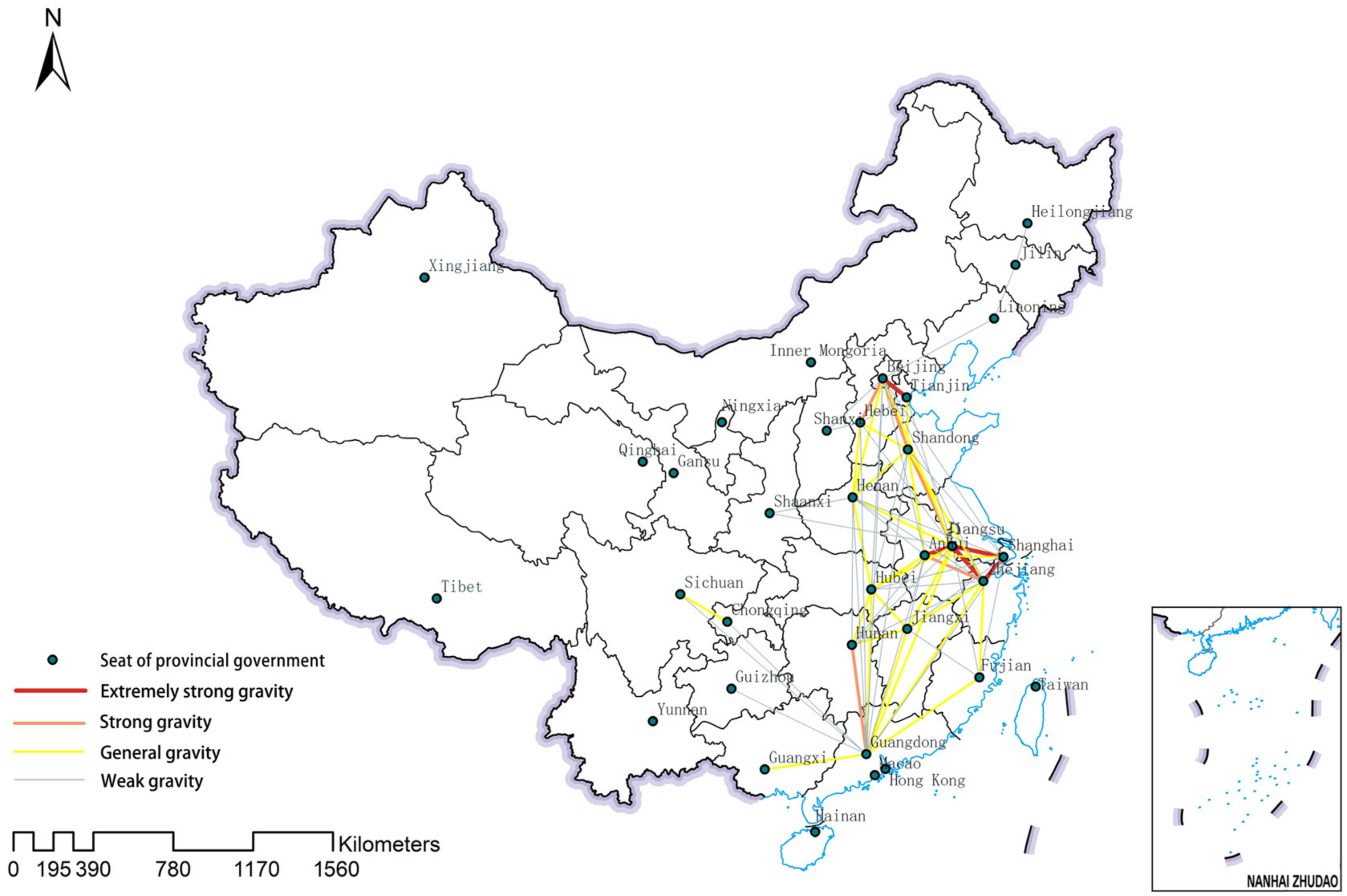
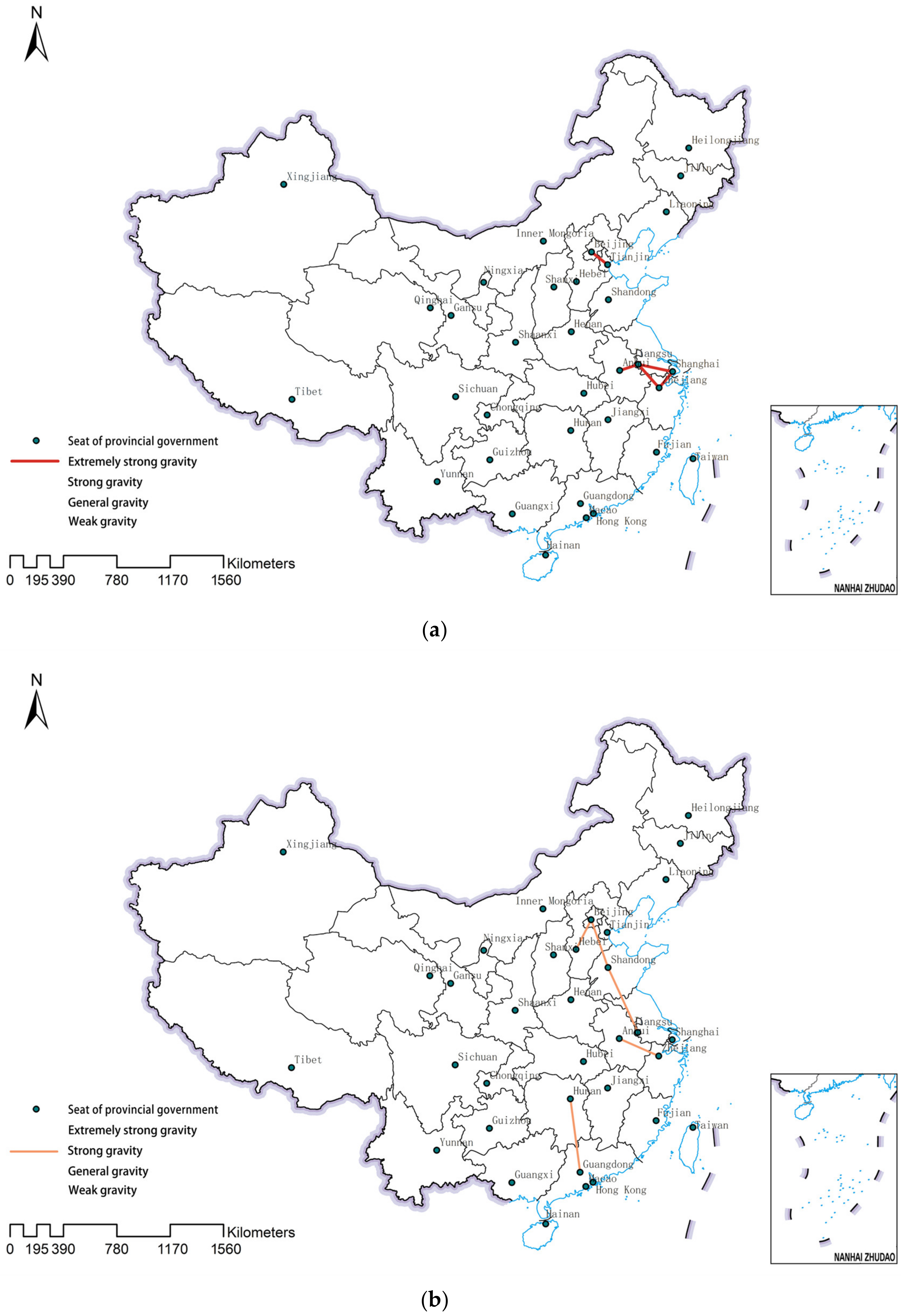
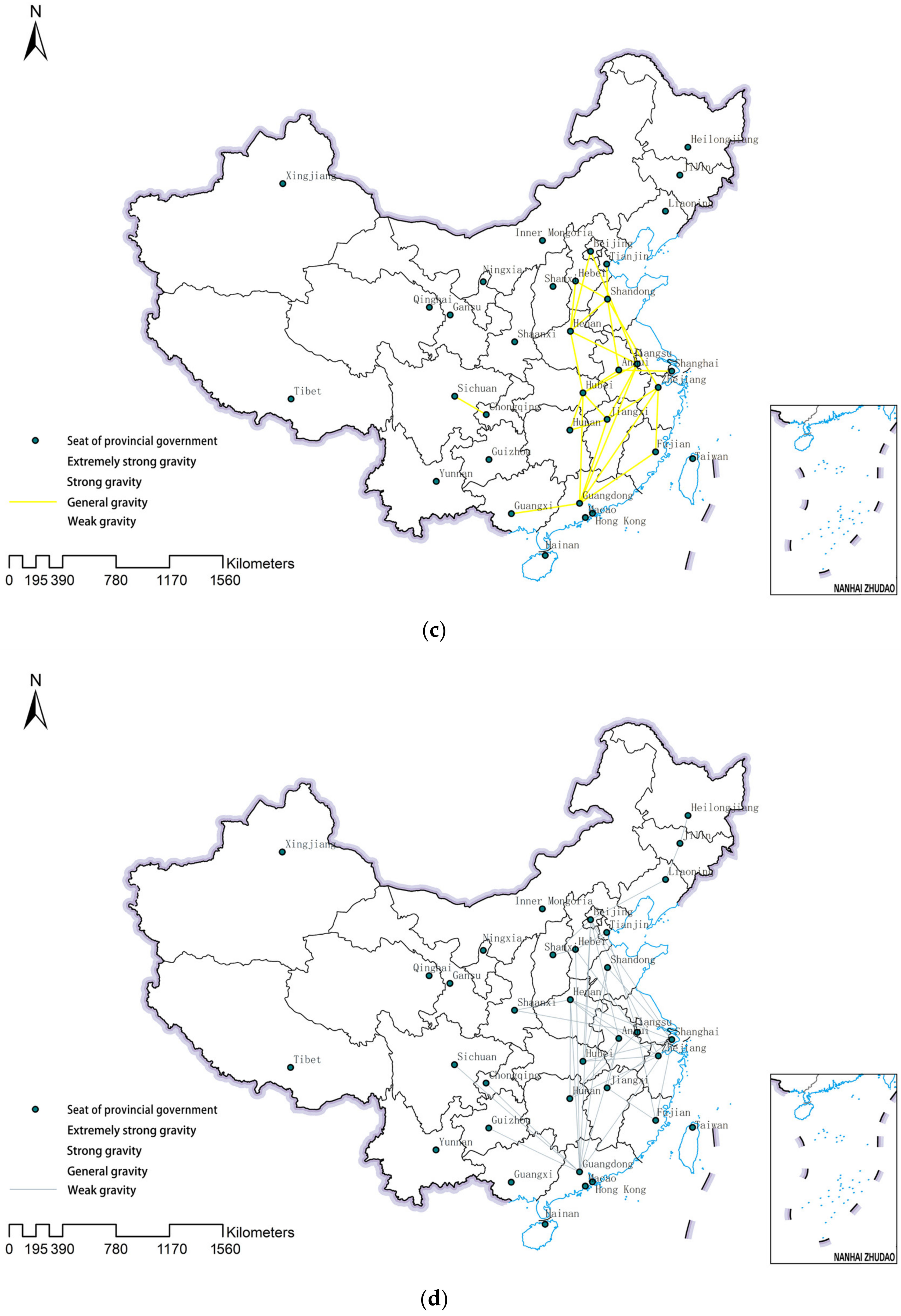

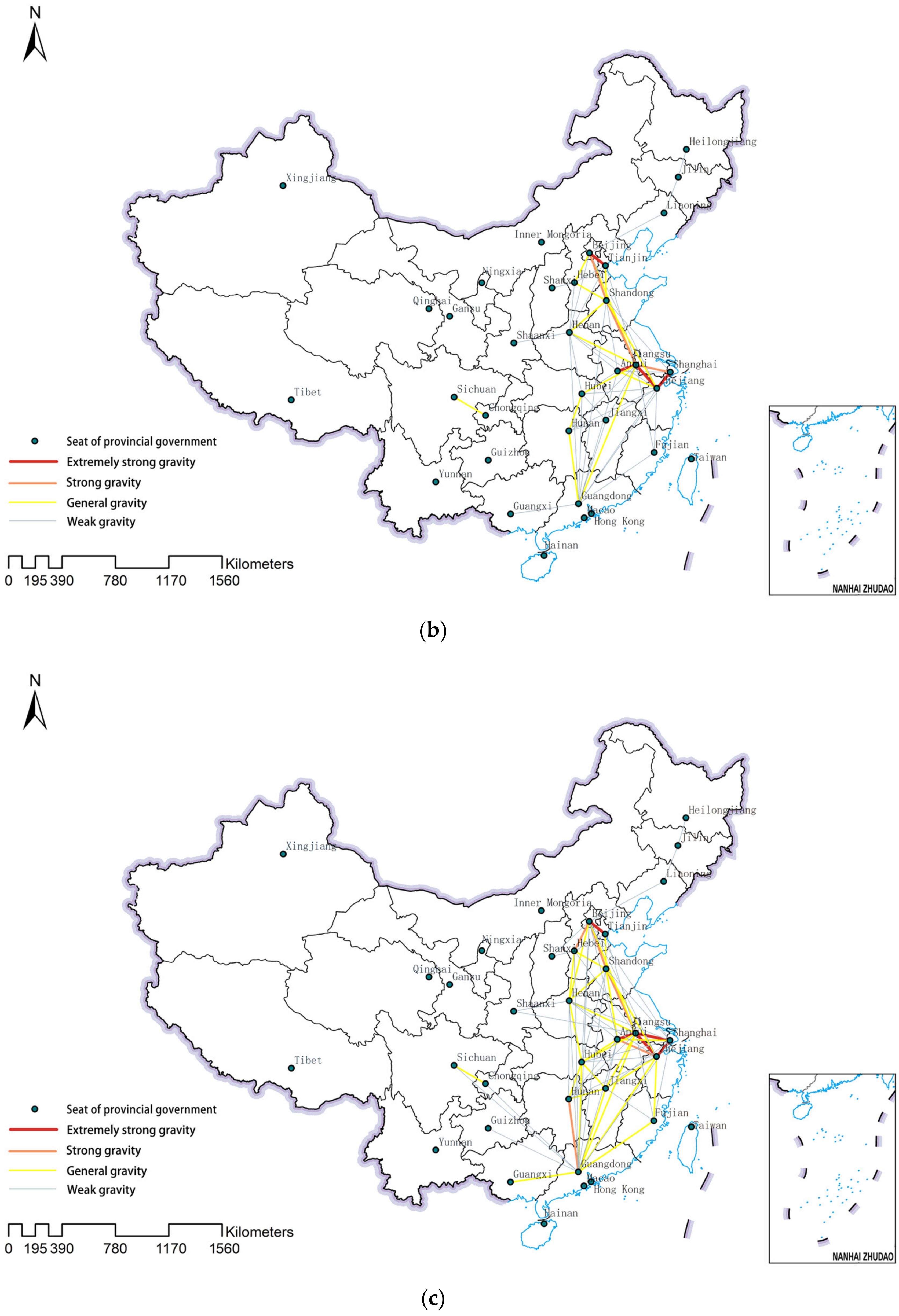

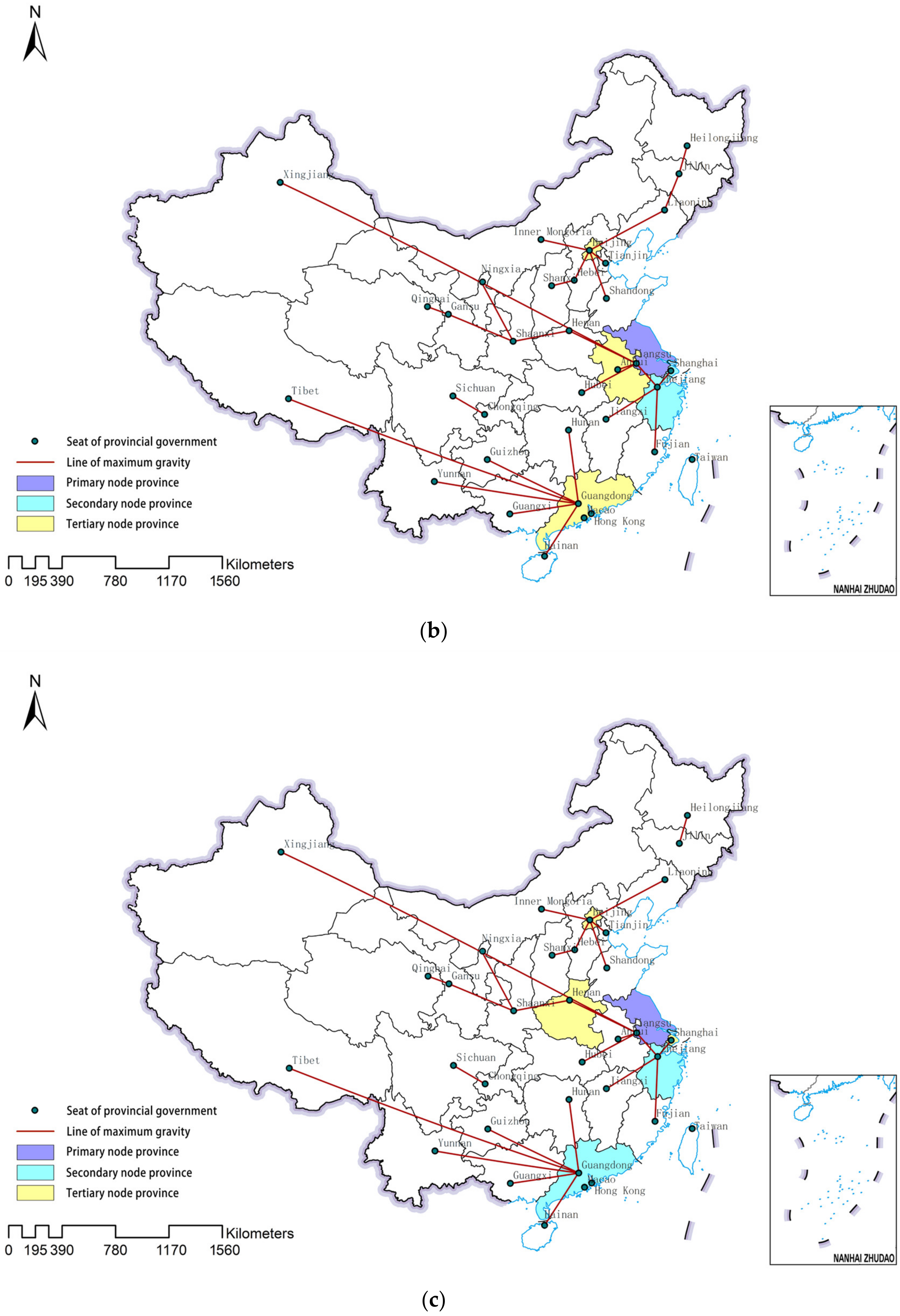
| Target Layer | Criterion Layer | Index Layer | |
|---|---|---|---|
| Scale of Outward Innovation | Innovation Environment | Public revenue Per capita GDP | CNY 10,000 CNY |
| Total postal business | CNY 10,000 | ||
| Total telecommunication services | CNY 10,000 | ||
| Number of Internet users | 10,000 households | ||
| Number of students in adult higher education | People | ||
| Innovation Input | Financial expenditure on education | CNY 10,000 | |
| Financial expenditure on science | CNY 10,000 | ||
| Number of legal entities in the scientific research and technology service industry | 10,000 People | ||
| Research and experimental development (R&D) personnel | Person/year | ||
| Research and experimental development (R&D) external expenditure | CNY 10,000 | ||
| Expenditure for new product development of industrial enterprises above designated size | CNY 10,000 | ||
| Innovation Output | Number of patent applications | Piece | |
| Number of patents granted | Piece | ||
| New product sales revenue of industrial enterprises above designated size | CNY 10,000 | ||
| Output value of new products of high-tech industry | CNY 10,000 | ||
| Number of scientific papers published | Article | ||
| Number of scientific and technological works | Article |
| Criterion Layer | Weight | Index Layer | Weight |
|---|---|---|---|
| Innovation Environment | 0.223 | Public revenue (CNY 10,000) Per capita GDP (CNY) | 0.046 |
| 0.017 | |||
| Total postal business (CNY 10,000) | 0.037 | ||
| Total telecommunication services (CNY 10,000) | 0.050 | ||
| Number of Internet users (10,000 households) | 0.041 | ||
| Number of students in adult higher education (People) | 0.032 | ||
| Innovation Input | 0.321 | Financial expenditure on education (CNY 10,000) | 0.025 |
| Financial expenditure on science (CNY 10,000) | 0.081 | ||
| Number of legal entities in science (10,000 People) | 0.038 | ||
| Research and experimental development (R&D) personnel (Person/year) | 0.047 | ||
| Research and experimental development (R&D) external expenditure (CNY 10,000) | 0.060 | ||
| Expenditure for new product development of industrial enterprises above designated size (CNY 10,000) | 0.070 | ||
| Innovation Output | 0.455 | Number of patent applications (piece) | 0.090 |
| Number of patents granted (piece) | 0.096 | ||
| New product sales revenue of industry (CNY 10,000) | 0.068 | ||
| Enterprises above designated size (CNY 10,000) | 0.124 | ||
| Number of scientific papers published (article) | 0.033 | ||
| Number of scientific and technological works (article) | 0.044 |
| Criterion Layer | Weight | Index Layer | Weight |
|---|---|---|---|
| Innovation Environment | 0.247 | Public revenue (CNY 10,000) Per capita GDP (CNY) | 0.038 |
| 0.010 | |||
| Total postal business (CNY 10,000) | 0.084 | ||
| Total telecommunication services (CNY 10,000) | 0.044 | ||
| Number of Internet users (10,000 households) | 0.040 | ||
| Number of students in adult higher education (People) | 0.031 | ||
| Innovation Input | 0.318 | Financial expenditure on education (CNY 10,000) | 0.026 |
| Financial expenditure on science (CNY 10,000) | 0.063 | ||
| Number of legal entities in the scientific (10,000 People) | 0.036 | ||
| Research and experimental development (R&D) personnel (Person/year) | 0.052 | ||
| Research and experimental development (R&D) external expenditure (CNY 10,000) | 0.062 | ||
| Expenditure for new product development of industrial enterprises above designated size (CNY 10,000) | 0.079 | ||
| Innovation Output | 0.435 | Number of patent applications (Piece) | 0.076 |
| Number of patents granted (Piece) | 0.082 | ||
| New product sales revenue of industrial (CNY 10,000) | 0.080 | ||
| Enterprises above designated size (CNY 10,000) | 0.127 | ||
| Number of scientific papers published (Article) | 0.032 | ||
| Number of scientific and technological works (Article) | 0.038 |
| Criterion Layer | Weight | Index Layer | Weight |
|---|---|---|---|
| Innovation Environment | 0.253 | Public revenue (CNY 10,000) Per capita GDP (CNY) | 0.041 |
| 0.010 | |||
| Total postal business (CNY 10,000) | 0.083 | ||
| Total telecommunication services (CNY 10,000) | 0.042 | ||
| Number of Internet users (10,000 households) | 0.032 | ||
| Number of students in adult higher education (People) | 0.045 | ||
| Innovation Input | 0.340 | Financial expenditure on education (CNY 10,000) | 0.026 |
| Financial expenditure on science (CNY 10,000) | 0.070 | ||
| Number of legal entities in the scientific (10,000 People) | 0.045 | ||
| Research and experimental development (R&D) personnel (Person/year) | 0.056 | ||
| Research and experimental development (R&D) external expenditure (CNY 10,000) | 0.062 | ||
| Expenditure for new product development of industrial enterprises above designated size (CNY 10,000) | 0.081 | ||
| Innovation Output | 0.407 | Number of patent applications (Piece) | 0.069 |
| Number of patents granted (Piece) | 0.073 | ||
| New product sales revenue of industrial (CNY 10,000) | 0.078 | ||
| Enterprises above designated size (CNY 10,000) | 0.124 | ||
| Number of scientific papers published (Article) | 0.033 | ||
| Number of scientific and technological works (Article) | 0.030 |
| Innovation Connection Level | In 2009 | In 2014 | In 2019 |
|---|---|---|---|
| Extremely strong gravity | 2 | 4 | 5 |
| Strong gravity | 3 | 3 | 5 |
| General gravity | 4 | 13 | 26 |
| Weak gravity | 38 | 45 | 39 |
| In 2009 | In 2014 | In 2019 | |||
|---|---|---|---|---|---|
| Scale of outward innovation Top 5 | Scale of outward innovation | Scale of outward innovation Top 5 | Scale of outward innovation | Scale of outward innovation Top 5 | Scale of outward innovation |
| Guangdong | 0.1383 | Guangdong | 0.1564 | Guangdong | 0.1913 |
| Jiangsu | 0.1223 | Jiangsu | 0.1355 | Jiangsu | 0.1129 |
| Shanghai | 0.0854 | Zhejiang | 0.0815 | Zhejiang | 0.0804 |
| Zhejiang | 0.0813 | Shandong | 0.0717 | Shanghai | 0.0562 |
| Beijing | 0.0801 | Beijing | 0.0628 | Beijing | 0.0552 |
| In 2009 | In 2014 | In 2019 | |||
|---|---|---|---|---|---|
| Scale of outward innovation Top 5 | Proportion in China (%) | Scale of outward innovation Top 5 | Proportion in China (%) | Scale of outward innovation Top 5 | Proportion in China (%) |
| Jiangsu | 18.30 | Jiangsu | 21.15 | Jiangsu | 20.38 |
| Zhejiang | 16.27 | Zhejiang | 14.71 | Zhejiang | 16.01 |
| Shanghai | 15.09 | Beijing | 10.19 | Shanghai | 11.83 |
| Beijing | 11.99 | Shanghai | 9.85 | Anhui | 8.87 |
| Tianjin | 9.14 | Anhui | 8.39 | Beijing | 7.15 |
Disclaimer/Publisher’s Note: The statements, opinions and data contained in all publications are solely those of the individual author(s) and contributor(s) and not of MDPI and/or the editor(s). MDPI and/or the editor(s) disclaim responsibility for any injury to people or property resulting from any ideas, methods, instructions or products referred to in the content. |
© 2023 by the authors. Licensee MDPI, Basel, Switzerland. This article is an open access article distributed under the terms and conditions of the Creative Commons Attribution (CC BY) license (https://creativecommons.org/licenses/by/4.0/).
Share and Cite
Zhu, K.; Gu, Z.; Li, J. Analysis of the China’s Interprovincial Innovation Connection Network Based on Modified Gravity Model. Land 2023, 12, 1091. https://doi.org/10.3390/land12051091
Zhu K, Gu Z, Li J. Analysis of the China’s Interprovincial Innovation Connection Network Based on Modified Gravity Model. Land. 2023; 12(5):1091. https://doi.org/10.3390/land12051091
Chicago/Turabian StyleZhu, Kai, Zhiling Gu, and Jingang Li. 2023. "Analysis of the China’s Interprovincial Innovation Connection Network Based on Modified Gravity Model" Land 12, no. 5: 1091. https://doi.org/10.3390/land12051091






